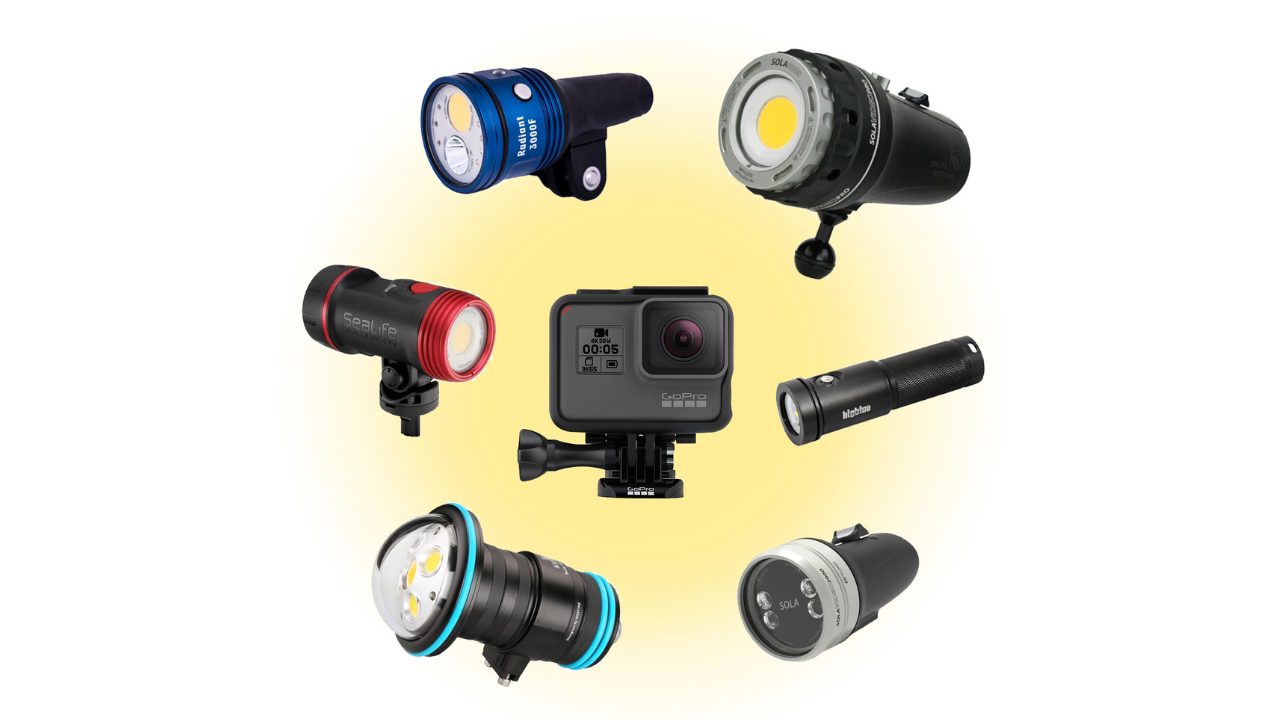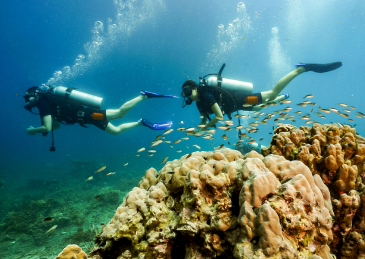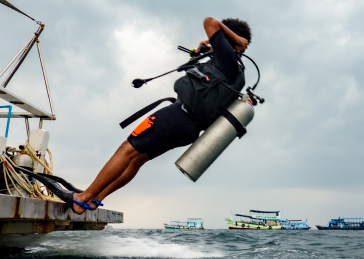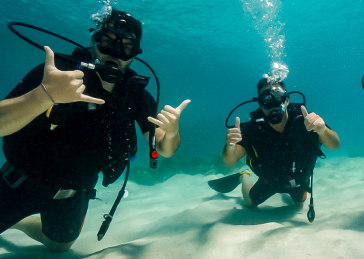Modified 12th June 2025
Essential GoPro Accessories for Capturing Your Koh Tao Dive
Capturing the underwater beauty of Koh Tao’s marine life requires more than just a standard GoPro. The unique challenges of underwater photography—from color absorption to pressure changes—demand specialized accessories that transform your action camera into a professional underwater filming system.
Whether you’re documenting your first diving experience or creating content at Koh Tao’s premier dive sites, this comprehensive guide covers every essential accessory you need for stunning underwater footage.
Complete GoPro Accessory Comparison Table
| Accessory Type | Primary Function | Depth Rating | Price Range | Essential Level |
|---|---|---|---|---|
| Waterproof Housing | Pressure protection | 60m (196ft) | $50-150 | Critical |
| Red/Magenta Filters | Color correction | Match housing | $20-40 | Critical |
| LED Light Array | Illumination/detail | 60m+ (196ft+) | $80-200 | High |
| Stabilizing Grip/Tray | Steady footage | Match housing | $30-100 | High |
| Float Arms | Neutral buoyancy | 60m+ (196ft+) | $25-60 | Medium |
| Backup Batteries | Extended recording | Sealed housing req. | $20-50 | Medium |
| HUD Display Attachment | Dive metrics overlay | Match housing | $100-300 | Low |
Critical Protection: Waterproof Housing Systems
While modern GoPro models offer basic waterproofing to 10 meters, essential GoPro accessories for capturing your Koh Tao dive must include professional-grade waterproof housing rated for depths up to 60 meters. This protection is vital for exploring deeper sites and protecting your investment from the intense pressure encountered during optimal diving conditions.
Professional housings handle pressures up to 6 ATM (60 meters), essential for accessing Koh Tao’s deeper dive sites safely.
Choose housings specifically designed for your GoPro model to ensure proper button access and seal integrity.
Quality housings feature replaceable O-rings and clear maintenance guidelines for long-term reliability.
Modern housings maintain full touchscreen functionality while providing complete underwater protection.
Color Correction: Red and Magenta Filter Systems
Water absorption fundamentally alters color perception underwater, making red and magenta filters among the most essential GoPro accessories for capturing your Koh Tao dive in true-to-life colors. These filters compensate for the loss of warm colors that occurs naturally as you descend.
Filter Selection Guide
- Red filters for blue water conditions (most Koh Tao sites)
- Magenta filters for green water or cloudy conditions
- Graduated filters for varying light conditions
- Quick-change systems for multi-depth dives
- Backup filters in case of loss or damage
Professional Lighting: LED Arrays and Positioning

Underwater lighting transforms good footage into exceptional content. As natural light diminishes with depth, professional LED arrays become essential GoPro accessories for capturing your Koh Tao dive with the clarity and detail that showcases the island’s incredible biodiversity.
Optimal Lighting Configuration
The key to professional underwater lighting lies in positioning rather than power. Position lights slightly away from your lens to minimize backscatter from suspended particles—a common issue when filming around Koh Tao’s coral formations.
Use dual LED lights mounted on adjustable arms no more than 12 inches from your camera. This configuration provides even illumination across your frame while reducing harsh shadows that can obscure the texture and colors of marine life.
Stabilization Systems: Grips and Tray Mounts
Even with GoPro’s built-in stabilization, underwater currents and buoyancy changes can create unwanted camera movement. Professional stabilization systems are essential GoPro accessories for capturing your Koh Tao dive with the smooth, professional quality that makes your footage stand out.
Simple and effective for basic stabilization. Choose ergonomic designs with textured surfaces for secure underwater handling.
Wider base provides superior stability and includes mounting points for lights and accessories in a single integrated system.
Allow precise positioning of lights and accessories while maintaining optimal balance throughout your dive.
Properly balanced systems reduce fatigue and allow for extended filming sessions without strain.
Buoyancy Management: Float Arms and Balance
Achieving neutral buoyancy with your camera rig is crucial for natural movement underwater. Float arms represent essential GoPro accessories for capturing your Koh Tao dive without the constant struggle against sinking or floating equipment that can distract from your filming focus.
Calculate the total weight of your camera, housing, lights, and accessories, then add sufficient float arms to achieve neutral buoyancy. Test your setup in shallow water before heading to deeper sites to ensure proper balance.
Power Management: Extended Recording Solutions
Nothing ruins great footage like a dead battery halfway through your dive. Extended power solutions are among the most practical essential GoPro accessories for capturing your Koh Tao dive from start to finish, especially during longer explorations of sites with rich marine biodiversity.
- High-capacity batteries: Extended recording time for longer dives
- External power banks: Continuous power for extended filming sessions
- Backup power options: Insurance against equipment failure
Post-Dive Processing: Editing Your Koh Tao Adventures

Creating compelling stories from your underwater footage requires the right editing tools. Professional software like Adobe Premiere Pro or Final Cut Pro offers advanced color grading capabilities essential for underwater footage, while user-friendly options like GoPro’s Quik app or CapCut provide streamlined editing for immediate sharing.
Essential Editing Techniques
- Color correction: Enhance natural colors lost to water absorption
- Stabilization: Smooth out remaining camera movement
- Clip selection: Choose the most compelling moments from your dive
- Music integration: Add soundtrack that complements the underwater experience
Gear Maintenance: Protecting Your Investment
Proper maintenance extends the life of your essential GoPro accessories for capturing your Koh Tao dive and ensures they’re ready for your next underwater adventure. The marine environment poses unique challenges that require specific care protocols.
Post-Dive Maintenance Checklist
- Rinse all equipment thoroughly in fresh water
- Remove salt and sand deposits from seals and joints
- Allow complete drying before storage
- Inspect O-rings for damage or wear
- Store in cool, dry location away from direct sunlight
- Test equipment functionality before next dive
Where to Source Accessories in Koh Tao
When planning your journey to Koh Tao, you’ll find GoPro accessories available at the mobile phone shop across from the large 7-Eleven on the main road between Mae Haad and Sairee. For a wider selection, Thailand’s version of Amazon—Lazada—offers comprehensive accessory options with 3-4 day delivery to the island.
Understanding Koh Tao’s development as a diving destination helps explain why the island has evolved to support underwater photography enthusiasts with both local suppliers and efficient delivery services.
Ready to create stunning underwater footage while learning to dive in one of the world’s most beautiful locations?
La Bombona Diving combines professional instruction with the perfect opportunity to practice your underwater filming skills. Our experienced instructors understand the challenges of underwater photography and provide guidance on both diving techniques and equipment use.
- Expert guidance on underwater camera techniques
- Access to diverse marine life perfect for filming
- Small class sizes for personalized attention
- Multiple certification levels to match your experience
- Professional instructors with underwater photography experience
- Flexible scheduling around optimal filming conditions
Don’t forget to bring your GoPro when fun diving so you don’t miss a thing.
Start Your Underwater Filming Journey – Fun Dive ฿2,000 (2 Dives)Perfect for testing your GoPro setup | Full day experience | Professional instruction included
Frequently Asked Questions
Dive with LBD: Your Gateway to Underwater Exploration
Whether you’re a curious beginner or a seasoned pro, our school is your portal to the wonders of scuba diving. Join us into the world beneath the waves.
READY TO GET STARTED?
Check our diving courses in Koh Tao



